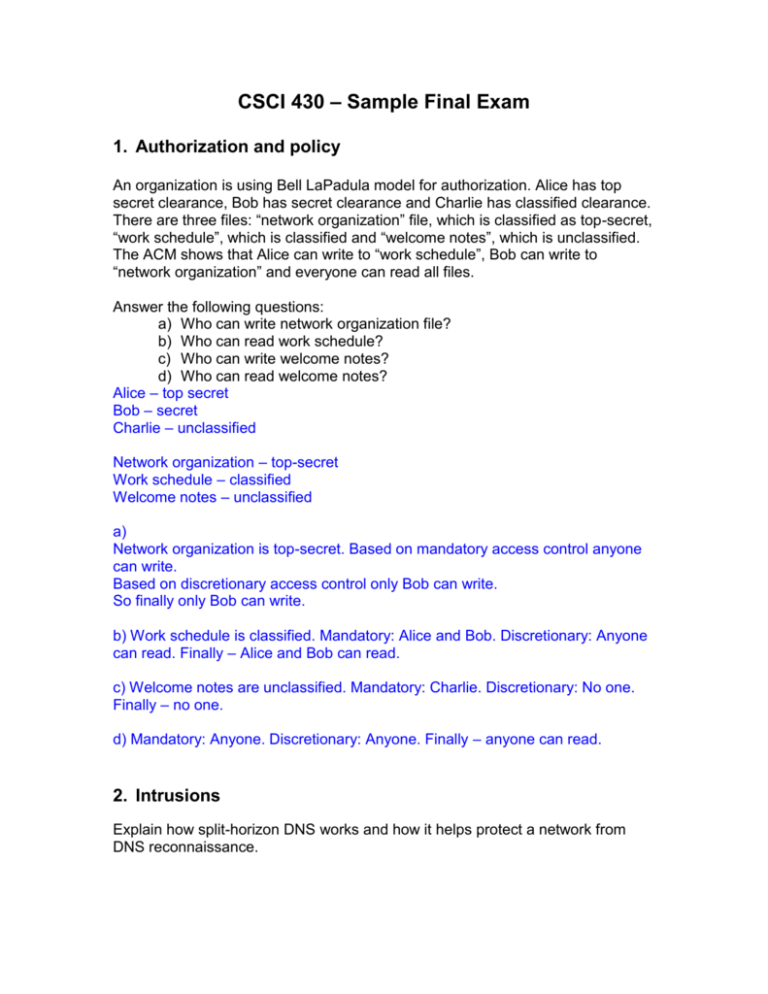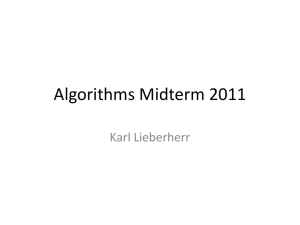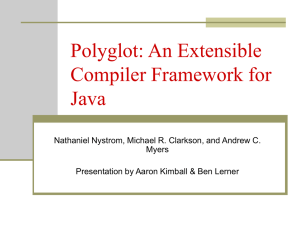Sample final 2
advertisement

CSCI 430 – Sample Final Exam 1. Authorization and policy An organization is using Bell LaPadula model for authorization. Alice has top secret clearance, Bob has secret clearance and Charlie has classified clearance. There are three files: “network organization” file, which is classified as top-secret, “work schedule”, which is classified and “welcome notes”, which is unclassified. The ACM shows that Alice can write to “work schedule”, Bob can write to “network organization” and everyone can read all files. Answer the following questions: a) Who can write network organization file? b) Who can read work schedule? c) Who can write welcome notes? d) Who can read welcome notes? Alice – top secret Bob – secret Charlie – unclassified Network organization – top-secret Work schedule – classified Welcome notes – unclassified a) Network organization is top-secret. Based on mandatory access control anyone can write. Based on discretionary access control only Bob can write. So finally only Bob can write. b) Work schedule is classified. Mandatory: Alice and Bob. Discretionary: Anyone can read. Finally – Alice and Bob can read. c) Welcome notes are unclassified. Mandatory: Charlie. Discretionary: No one. Finally – no one. d) Mandatory: Anyone. Discretionary: Anyone. Finally – anyone can read. 2. Intrusions Explain how split-horizon DNS works and how it helps protect a network from DNS reconnaissance. There are two DNS servers – one public one private. Public one knows only IPs of public servers. Private knows IPs of internal servers. External clients learn only IP of public DNS. All internal clients use private DNS. If a server needs to be accessed by both internal and external clients it has two IPs, one public one private. External attackers can only learn about public servers but not about internal ones. 3. DDoS I propose a DDoS defense in which the victim server under attack instructs all its clients to send a lot of traffic to the server. The server then flags those clients that did send required (high) traffic volume as legitimate. The assumption here is that attackers already send at max capacity and cannot increase their sending rate so the server will easily flag them as malicious. a) What are the advantages of this approach? Simple and easy to implement. Works if assumption is correct. b) What are the disadvantages of this approach? If assumption is not correct it doesn’t help. Creates even more congestion. c) If you were the attacker how would you trick this defense into flagging you as a legitimate client? Assume you have unlimited resources at your disposal. Send at a low rate and then increase when the victim asks you to increase rate – get flagged as legitimate client. d) Imagine that instead of instructing clients to send lot of traffic the server sent them a computational puzzle to solve. Does this solve any of the disadvantages you listed? Does it introduce any new disadvantages? It helps with congestion. It helps even if attacker is not sending at peak rate or if legitimate users are sending at their peak rate. Slows down legitimate traffic. CPU power differs a lot between machines so it’s hard to generate puzzles that are equally difficult for everyone. 4. Worms In a paper we covered in class authors discuss how quickly global worm defense would have to work, where should it be deployed and they measure two types of defenses. a) Which defenses they considered and which one was better? Address blacklisting (if a machine is proven to be infected blacklist it and drop all its traffic) Worm signatures (use a signature to drop all worm scans) Worm signatures performed better. b) How quickly should defenses work to stop the worm Address blacklisting within seconds. Worm signatures within minutes. c) Where should they be deployed At big ISPs 5. Botnets There are two ways to enumerate botnets: passive observation of traffic (e.g., infiltrate and then observe all reports passing through the node) and active traversal of P2P structure (e.g. querying each node for its peers and then repeating this for each peer). a) Which approach gives higher counts and why? Passive was better – it can see traffic from firewalled hosts b) Both approaches may miscount since they assume that one IP = one bot. Explain why this assumption is not true (multiple reasons exist) and how it reflects on a total count (does it make it smaller or larger than the true count). DHCP – higher (one machine can get multiple IPs) and lower (same IP can be owned by multiple hosts at multiple times) NATs – lower (one IP per network) Churn – higher (machines can be cleaned or disconnected) 6. Privacy Alice configures Tor to use 4 Tor routers for her route: T1, T2, T3, T4. Alice's outgoing connection goes through these Tor routers in order of lowest to highest (Alice->T1->T2->T3->T4->Destination). a) If we represent the layers of Tor encryption with parenthesis, Alice's encrypted message looks like this: ((((message)K_a)K_b)K_c)K_d where K_x is the public key for Tor router "x". For Alice's outgoing path (T1->T2->T3->T4), replace a, b, c and d with the appropriate number (1-4) to show how Alice's message is encrypted. ((((message)K_4)K_3)K_2)K_1 b) Normally Tor routes only "bounce" through three Tor routers. What is the downside of Alice using four? It takes longer because it’s a longer route and because of encryption c) If Eve can only see TCP/IP headers (ie. no application payload) which go between T4 and Alice's final destination, does Eve know which connection is Alice's? Justify your answer. No, she only sees that packets go from T4 to Bob d) If Eve can see full packets (headers + payload) which go between T4 and Alice's final destination, does Eve know which connection is Alice's? Justify your answer. No, because Alice should encrypt her traffic so payload is encrypted (with Bob’s public key)








